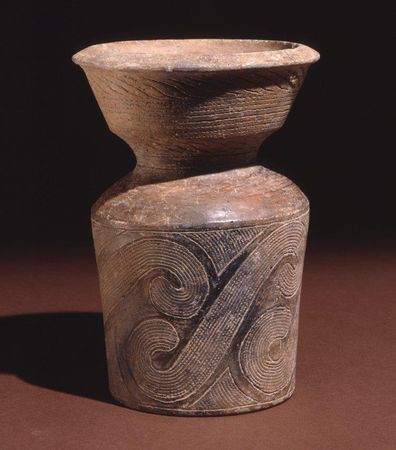Tazza. Vietnam, Phung Nguyen, 3000BC-1500BC.
Tazza. Made of pottery. Height: 8.2 inches. Diameter: 5.8 inches. Vietnam, Phung Nguyen, 3000BC-1500BC. From Sir Augustus Wollaston Franks. Registration number: Franks.3100. © The Trustees of the British Museum
The next early phase of Vietnamese earthenware manufacture is represented by the first Vietnamese ceramic to reach the British Museum. It came here through Sir Augustus Wollaston Franks (1826-97), a former keeper in the Museum, who never travelled to Asia himself but used an international web of contacts with first hand experience of countries there to make purchases on his behalf. These suppliers were a mixture of consular officials posted abroad, academics engaged in field researches or excavations, members of the armed forces and missionaries. As agents they acquired materials which were unavailable on the European art market. In August 1892, Charles Schefer, a collector and influential French Sinologist from L’Ecole Spéciale des Langues Orientales Vivantes in Paris sent Franks a case of pottery and porcelain made in Vietnam, Korea and Cambodia. One of the most magnificent items sent by Schefer was this Neolithic pottery beaker with engraved decoration dating to the second millennium BC from north Vietnam in the area of the Red River Delta. Similar items with stippled designs have been excavated at Go Bang in Vinh Phu Province and are now in the National Museum of Vietnamese History in Hanoi. These are also described as belonging to the Phung Nguyen culture after the 1959 excavations of the village of Phung Nguyen in Phu Tho province. This beaker shows a lot of sand and shell inclusions which were added to the clay paste to strengthen the vessel during the firing process.

/https%3A%2F%2Fprofilepics.canalblog.com%2Fprofilepics%2F1%2F0%2F100183.jpg)
/https%3A%2F%2Fstorage.canalblog.com%2F03%2F02%2F119589%2F96711876_o.jpg)
/https%3A%2F%2Fstorage.canalblog.com%2F11%2F31%2F119589%2F94773502_o.jpg)
/https%3A%2F%2Fstorage.canalblog.com%2F20%2F83%2F119589%2F94772815_o.jpg)
/https%3A%2F%2Fstorage.canalblog.com%2F26%2F72%2F119589%2F75604929_o.jpg)
/https%3A%2F%2Fstorage.canalblog.com%2F59%2F60%2F119589%2F26458628_o.jpg)




/image%2F1371349%2F20240309%2Fob_cc1354_41.png)
/image%2F1371349%2F20240227%2Fob_aab771_ash-glazed-lian-container-with-three-l.jpg)
/http%3A%2F%2Fstorage.canalblog.com%2F11%2F09%2F119589%2F129818349_o.jpg)
/http%3A%2F%2Fstorage.canalblog.com%2F55%2F89%2F119589%2F129509226_o.jpg)